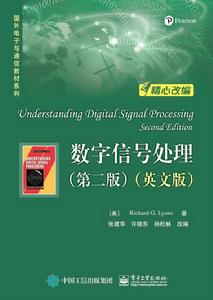圖書內容
本書在Richard G. Lyons所著Understanding Digital Signal Processing, Second Edition的基礎上進行了改編,針對通信類學校本科教學大綱,刪除了教學中一般不涉及的內容,調整了章節順序,並增加了z反變換、濾波器結構、線性相位FIR濾波器和其結構、模擬濾波器簡介的內容,使教內容材更加完整。全書在概述了離散序列和系統的定義和實例之後,詳細討論了離散系統的特性、信號的離散化和離散卷積、z變換、離散時間傅立葉變換和離散傅立葉變換、快速傅立葉變換、數字濾波器結構、以及有限和無限脈衝回響數字濾波器的設計等基本概念和基本理論。
書中涉及的數學知識以簡明形式給出,深入淺出,易於理解。本書每章都增加了例題、習題和MATLAB例題,以便加強對每章內容的理解和掌握。
目錄
Chapter 1 Discrete Sequences and Systems 1
1.1 Discrete Sequences and Their Notation 1
1.1.1 Discrete-time Signals 2
1.1.2 Frequently Used Discrete Sequences 7
1.2 Signal Amplitude, Magnitude, Power 9
1.3 Signal Processing Operational Symbols 10
1.4 Introduction to Discrete Linear Time-Invariant Systems 12
1.5 Discrete Linear Systems 12
1.5.1 Example of a Linear System 12
1.5.2 Example of a Nonlinear System 14
1.6 Time-Invariant Systems 16
1.6.1 Example of a Time-Invariant System 16
1.7 The Commutative Property of Linear Time-Invariant Systems 17
1.8 The Causality Property of Linear Time-Invariant Systems 18
1.9 The Stability Property of Linear Time-Invariant Systems 18
1.10 Analyzing Linear Time-Invariant Systems 19
1.11 Problems 20
1.12 MATLAB Applications 22
1.12.1 Applications 22
1.12.2 Examples 23
1.12.3 Exercises 24
Chapter 2 Periodic Sampling 25
2.1 Aliasing: Signal Ambiguity in the Frequency Domain 25
2.2 Sampling Low-Pass Signals 29
2.3 A Generic Description of Discrete Convolution 32
2.3.1 Discrete Convolution in the Time Domain 33
2.3.2 The Convolution Theorem 36
2.3.3 Applying the Convolution Theorem 39
2.4 Problems 42
2.5 Matlab Applications 43
2.5.1 Applications 43
2.5.2 Examples 44
2.5.3 Exercises 46
Chapter 3 Z-Transform 47
3.1 The z-Transform 47
3.1.1 Poles and Zeros on the z-Plane and Stability 49
3.1.2 The ROC of z-Transform 50
3.1.3 The Properties of z-Transform 53
3.2 The Inverse z-Transform 55
3.2.1 General Expression of Inverse z-Transform 55
3.2.2 Inverse z-Transform by Partial-Fraction Expansion 58
3.3 Problems 61
3.4 MATLAB Applications 63
3.4.1 Applications 63
3.4.2 Examples 64
3.4.3 Exercises 67
Chapter 4 The Discrete Fourier Transform 68
4.1 Interpreting the DFT 69
4.2 Understanding the DFT Equation 71
4.2.1 DFT Example 1 74
4.3 DFT Properties 81
4.3.1 DFT Symmetry 81
4.3.2 DFT Linearity 83
4.3.3 DFT Magnitudes 83
4.3.4 DFT Frequency Axis 84
4.3.5 DFT Shifting Theorem 85
4.4 Inverse DFT 87
4.5 DFT Leakage 88
4.6 Windows 94
4.7 DFT Resolution, Zero Padding, and Frequency-Domain Sampling 101
4.8 Frequency Response 104
4.9 Problems 106
4.10 Matlab Applications 107
4.10.1 Applications 107
4.10.2 Examples 108
4.10.3 Exercises 111
Chapter 5 The Fast Fourier Transform 112
5.1 Relationship of the FFT to the DFT 112
5.2 FFT Alogrithm 113
5.3 Derivation of the Radix-2 FFT Algorithm 114
5.4 FFT Input/Output Data Index Bit Reversal 120
5.5 Radix-2 FFT Butterfly Structures 121
5.6 Efficiently Performing the FFT of Real Sequences 127
5.6.1 Performing Two N-Point Real FFTs 127
5.6.2 Performing a 2N-Point Real FFT 133
5.7 Discrete Convolution using FFT 137
5.7.1 Overlap-added 138
5.7.2 Overlap-saved 138
5.8 IFFT Algorithm 140
5.9 Problems 143
5.10 Matlab Applications 144
5.10.1 Applications 144
5.10.2 Examples 144
5.10.3 Exercises 146
Chapter 6 Filter Structure 147
6.1 Block Structure 147
6.2 Mason and Transpose Theorem 149
6.2.1 Mason誷 Rule 149
6.2.2 Transpose Theorem 150
6.3 Example of Filter Structures 151
6.3.1 IIR Filter Structure 151
6.3.2 FIR Direct Structure 158
6.3.3 FIR Cascade Structure 158
6.4 Problems 159
6.5 Matlab Applications 162
6.5.1 Applications 162
6.5.2 Examples 163
6.5.3 Exercises 167
Chapter 7 Finite Impulse Response Filters 168
7.1 An Introduction to Finite Impulse Response (FIR) Filters 169
7.2 Properties of FIR Filters 172
7.2.1 Convolution in FIR Filters 172
7.2.2 Linear phase FIR Filter 181
7.2.3 Linear Phase FIR Filter Structure 188
7.2.4 FIR Filter Poles and Zeros 194
7.3 Low-Pass FIR Filter Design 196
7.3.1 Window Design Method 197
7.3.2 Windows Used in FIR Filter Design 204
7.3.3 Examples to Design Linear Phase Low-Pass FIR Filter 210
7.4 Examples to Design Other Types Linear Phase FIR Filter 215
7.5 Problems 220
7.6 Matlab Exercises 223
7.6.1 Applications 223
7.6.2 Examples 223
7.6.3 Exercises 224
Chapter 8 Infinite Impulse Response Filters 226
8.1 An Introduction to Infinite Impulse Response Filters 227
8.2 The Laplace Transform 229
8.2.1 Poles and Zeros on the s-Plane and Stability 234
8.3 Analog Low-Pass Filters 239
8.3.1 Introduction 240
8.3.2 Approximation of analog filter characteristics 240
8.3.3 Butterworth Approximation 242
8.3.4 Chebyshev Approximation 247
8.4 Impulse Invariance IIR Filter Design Method 253
8.4.1 Impulse Invariance Design Method 1 Example 258
8.4.2 Impulse Invariance Design Method 2 Example 260
8.5 Bilinear Transform IIR Filter Design Method 266
8.5.1 Bilinear Transform Design Example 271
8.6 Low-Pass IIR Filter Design 274
8.6.1 Example of Low-Pass IIR Digital Filter Design 274
8.6.2 a Brief Comparison of IIR and FIR Filters 277
8.7 Other Types IIR Filter Design 278
8.8 Problems 284
8.9 Matlab Exercises 286
8.9.1 Functions of IIR Design 286
8.9.2 Examples 287
8.9.3 Exercises 288

